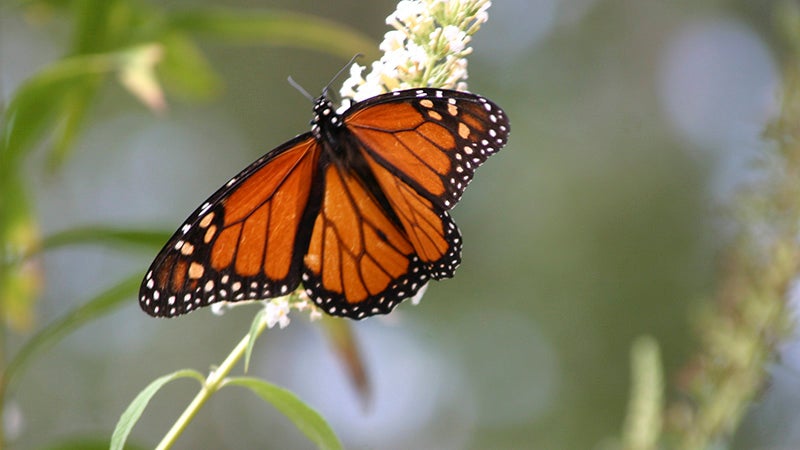How to attract Monarch butterflies
Published 7:00 am Wednesday, July 5, 2017

- File photo courtesy of Crosby Arboretum
By Patricia R. Drackett, Director and Assistant Extension Professor of Landscape Architecture
The Crosby Arboretum, Mississippi State University Extension Service
In recent years there has been an incredible explosion of information focused on the decline in monarch butterfly populations, and how the public can help. Home gardeners have been quick to rally by planting milkweed, the monarch’s host species.
How can you provide for Monarch butterflies in your own garden? Obviously, plant lots of milkweed! But it’s important to understand that the butterflies also require nectar for fuel. They need nectar when they first arrive in the U.S. in springtime after overwintering in Mexico, in addition to needing to find milkweed to lay their eggs on.
During their fall migration to the oyamel fir forests in central and southern Mexico, adult monarchs need nectar, not milkweed, because they will not be laying eggs. They have their reproduction development put “on hold”. But they do need lots of nectar! So, plan to include both early spring blooming plants and fall nectar species for them in your garden.
You can track monarch butterfly spring and fall migration, and report your own sightings, at https://www.learner.org/jnorth/monarch/.
Although resources often urge gardeners to plant native milkweeds, there are few sources in our area. The most commonly available milkweed is an attractive tropical variety (A. curassavica) with deep orange and yellow blooms. Tropical milkweed is very easy to grow, but it unfortunately can harbor a disease that cripples monarch butterflies.
Research also suggests that tropical milkweed is having a detrimental effect on monarch migration patterns, by causing the butterflies to remain in coastal areas during the fall months and lay eggs, rather than migrating to Mexico. The Arboretum often receives calls in the fall from frantic gardeners reporting monarch chrysalises on their tropical milkweed, when freezing weather has been forecast.
Until native milkweeds are readily available, tropical milkweed will continue to be the “go to” monarch host plant in coastal Mississippi.
Gardeners are advised to simply cut back their tropical milkweed to stubble in October, during the monarch’s fall migration period. However, always use caution when pruning milkweed. If the sap is wiped into the eyes it can cause pain and temporary blindness.
According to Dr. Wayne Morris, a field botanist who assisted Dr. Sidney McDaniel with the Arboretum’s plant inventory in the 1980’s, there are at least fifteen species of milkweed native to Mississippi with the potential for cultivation. This information has been compiled into a handout, available at the Arboretum.
We’re currently conducting milkweed seed and garden trials at the South Mississippi Branch Experiment Station in Poplarville. So far, the species showing the most promise for the home garden are: Swamp Milkweed (A. incarnata), Aquatic Milkweed (A. perennis), A. tuberosa (Butterfly Weed), Green Antelopehorn (A. viridis), and Whorled Milkweed (A. verticillata).
One of the important lessons we’ve learned is that seed obtained from sources within our own ecoregion (No. 232, the Outer Coastal Plain Mixed Forest Province, according to the map compiled by Robert G. Bailey) is better suited to coastal Mississippi gardens than seed originating from sources outside our ecoregion.
See Bailey’s “Ecoregions of the United States” map on the USDA Forest Service website, along with information about these ecosystems, at https://www.fs.fed.us/rm/ecoregions/products/map-ecoregions-united-states/#
The Arboretum currently carries Ecoregion 232 Aquatic Milkweed (A. perennis) and Swamp Milkweed (A. incarnata). The plants were propagated from Florida ecotype seed and have a greater heat tolerance for Deep South climates.
We are grateful to the Pearl River County Master Gardeners, who have recently submitted an application for our Pollinator Garden to be certified as Monarch Waystation. Thanks to their efforts, we hope to be “official” soon! Over 16,000 waystations have been certified to date. For more information, see http://www.monarchwatch.org/waystations/.
Attend the Children’s Insect Worshop with Hancock County Extension Agent Christian Stephenson on Friday, July 7, from 10:00 AM to Noon. Cost for non-members’ children is $2 (no charge for adults). Children of all ages are welcome, and must be accompanied by parent or guardian.
An All About Hummingbirds program takes place on Saturday, July 22, from 10:00 to 11:00 AM with hummingbird bander James Bell. Non-member adults $5, non-members’ children $2.
Do you enjoy writing? Attend “Bringing Nature to Life in Your Writing”, with local writer Mary Beth Magee on Saturday, July 29, from 10 AM to Noon. Non-member adults, $7.
Space in our programs is limited. Call 601-799-2311 to register. For more information, see www.crosbyarboretum.msstate.edu. The Arboretum is located in Picayune, I-59 Exit 4, at 370 Ridge Road (south of Walmart and adjacent to I-59).


